Sony Cyber-shot DSC-RX100 IV review: Introduction
At a glance:
- 20.1-million pixel, 1in-type Exmor RS CMOS sensor
- Bionz X image processor
- ISO 125-12,800 (expandable to ISO 80/100)
- 3in, 1.23-million-dot tilting LCD screen
- 16fps continuous shooting
- £849
Back in 2012 Sony redefined expectations for small cameras by fitting a large, high resolution 20.1-million-pixel 1-in sensor into the pocket-sized RX100. Every year since then, it has taken its advanced point-and-shoot compact and improved it for the better. The arrival of the RX100 II back in 2013 was a step up from the original RX100 and introduced a new backside illuminated CMOS sensor, tiltable LCD screen and Wi-fi connectivity.
A year later the RX100 III arrived having received further attention from Sony’s engineers. Its shorter 24-70mm zoom range enabled the manufacturer to improve the maximum aperture to f/1.8-2.8 from f/1.8-4.9 on previous versions. The real standout feature on the RX100 III however was the introduction of its ingeniously designed pop-up electronic viewfinder. When we revealed our verdict of the RX100 III just over a year ago it was difficult to see where future developments would be made, but the new RX100 IV arrives with yet more attractive features and improvements to ensure it’s right up there as one of the very best pocket-sized compact cameras.

The Sony Cyber-shot RX100 IV with the EVF raised from the top corner of the body
Sony Cyber-shot DSC-RX100 IV Review – Features
For the last two generations Sony has rolled out the RX100 II and the RX100 III with a 20.2-million-pixel Exmor R BSI-CMOS sensor. Though the resolution remains exactly the same on the RX100 IV, the configuration of the sensor is different. Rather than employing the previously used BSI, or back-illuminated sensor, the new Exmor RS chip incorporates a stacked design that repositions the circuitry from the edges of the sensor to behind the photodiodes, or pixels, themselves.
The benefit of this is that it prevents high volumes of data having to work their way to the edge of the sensor, resulting in a data readout speed that Sony claims to be five times as quick as the existing Exmor R sensor. To make this all possible and to ensure the RX100 IV’s Bionz X processor doesn’t falter with the extra demands, Sony has incorporated extra DRAM memory at the rear of the sensor to act as a buffer and gradually feed the data to the image processor at a speed it can deal with.
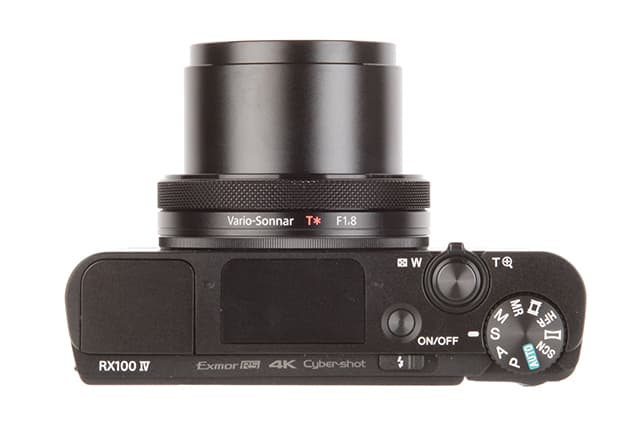
The RX100 IV features the same f/1.8-2.8 (24-70mm equivalent) lens as previously seen on the RX100 III
This more sophisticated sensor design allows the RX100 IV to be faster in a number of key areas. Not only can it rattle off a continuous burst at up to 16fps, it can also shoot at shutter speeds up to 1/32,000sec thanks to the new electronic shutter that deploys beyond 1/2000sec.
The new sensor and speed benefits don’t end here. Slow motion video recording is possible up to an incredible 1000fps (visit the performance section of this review to view our examples) and 4K video recording is available with full sensor readout and bit rates up to 100Mbps. To take advantage of the new movie features, users are required to insert a UHS-I U3 SDXC memory card; with a slower card, or one smaller than 64GB, the features will be disabled. The RX100 IV also enables 17-million pixel still images to be captured whilst recording a movie thanks to the addition of a new Auto Dual Rec release function.

The Sony RX100 IV has a smooth metal body and the control ring around the lens features a new diamond-knurled texture
Like the RX100 III, the native sensitivity range runs between ISO 125-12800 with the option to expand it to ISO 80 and ISO 100. Aside from the new sensor design, the RX100 IV shares many similarities with the RX100 III. It has the same f/1.8-2.8 (24-70mm equivalent) Zeiss Vario-Sonnar T* lens that features a built-in ND filter. Wi-Fi and NFC connectivity are both present and there’s a 3-in, 1.23-million-dot articulated screen at the rear, though regrettably it’s still not the touchscreen type we’ve been longing to see on an RX100 model for a while. The pop-up EVF sees a jump up in resolution to 2.36-million-dots from 1.44-million-dots and in the same fashion as before it’s positioned beside a popup flash.
The RX100 IV accepts the same NP-BX1 battery, but the battery life has taken a bit of a hit and is now rated at 280 shots per charge – 40 less than the RX100 III, but still 70 more than one of its key rivals in the market – the Canon PowerShot G7 X.
Sony Cyber-shot DSC-RX100 IV Review – Build and Handling
Sony has taken the ‘if it ain’t broke don’t fix it’ approach to the design and the only way of identifying that it’s a new camera is by the model name and 4K branding on the top plate. The dimensions are identical to the RX100 III and it weighs just 8 grams more.
The magnesium alloy body and robust feel suggests it’ll survive the test of time, the only downside of the premium metal finish being is that it doesn’t offer much in the way of grip and there’s only a tiny rubberised thumb rest at the rear to prevent it slipping from your grasp. Attaching a wrist strap or neck strap is therefore imperative to avoid damage and a costly repair bill.

The design is virtually identical to the RX100 III, with a mode dial positioned at the top right and a similar layout of buttons beneath
Flicking the finder switch automatically fires the camera into life, but users must remember to pull the EVF towards them to engage it correctly and obtain access to the dioptre. Holding the EVF up to the eye presents a clearer and sharper view than the RX100 III, and in high-contrast conditions where reflections on the screen can hinder composition and make it difficult to review images it’s a useful feature to have.
The EVF doubles up as a great way of supporting the camera too and by bracing it up against my eye I found I was able to resolve sharper long exposure images than by holding the camera at arms length. With the EVF pushed down and hidden away it’s easy to forget it’s there. I got into a routine of using the EVF to switch the camera on and off, but for any spur of the moment shots the on/off button remains the fastest way of firing the camera into life.

The Sony RX100 IV can be turned on and off by raising and collapsing the pop up electronic viewfinder
It’s easy to change the exposure settings via the rear control dial, and a quick press of the Fn button by default reveals an on-screen menu for the most common shooting, image and exposure settings. The second control ring around the lens offers dual control of shutter speed and aperture in manual mode, while it can be used to control ISO, White Balance and exposure compensation (+/-3EV). It has a new diamond-knurled texture that provides fractionally more grip than the RX100 III and is effective at operating the zoom precisely when it’s setup for this purpose.
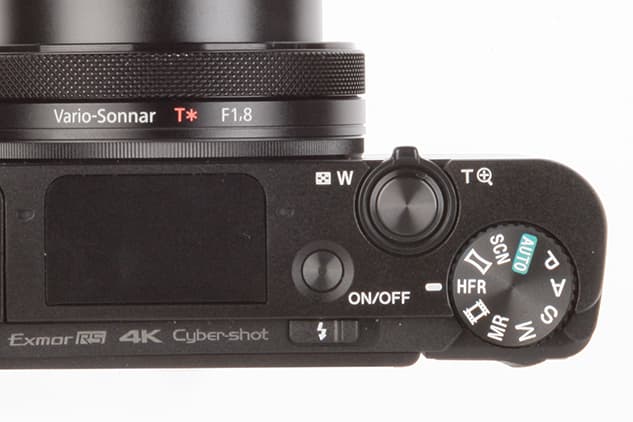
The new High Frame Rate (HFR) mode can be selected quickly via the mode dial
To free up space on the mode dial for the new high frame rate (HFR) feature that I’ll touch on shortly, both intelligent Auto and Superior Auto modes have been merged into the single Auto setting. Space is rather limited beside the screen and the playback, menu and Fn buttons are on the small side – no smaller than the RX100 III I must add, but it should be pointed out they’re best suited to those with small fingers.
Sony Cyber-shot DSC-RX100 IV Review – Performance
The RX100 IV’s focusing performance is comparable to the RX100 III and the contrast detection system is hasty by compact camera standards. The claimed 0.09sec acquisition speed is only 0.03secs slower than Sony’s A6000 that uses a more sophisticated hybrid AF system. There’s focus tracking and face detection, but without a touchscreen you’re reliant on tapping, or holding the directional buttons to reposition the AF-point around the frame. As we said before when we reviewed the RX100 III, adding a touchscreen would make for more intuitive autofocus operation, but this would have undoubtedly made RX100 IV even more expensive than it already is.
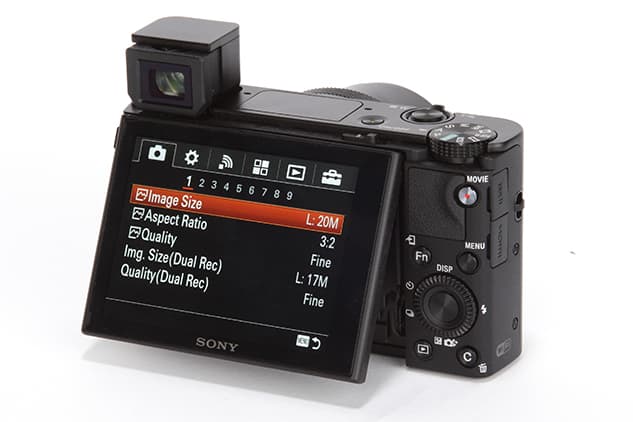
The tilting display is excellent for high and low angled shots, but regretfully it’s not the touchscreen type
Loaded with a Lexar Professional 2000x SDXC UHS-II 64GB memory card and set to speed priority continuous, the RX100 IV rattled out 44 extra fine JPEGs at 16fps – an extremely impressive figure made possible by fitting it out with the new Exmor RS sensor. Switching the file format to Raw lowers the frame rate to 9fps and 29 images were recorded at this speed before the buffer kicked in and prevented any more being taken. As for the speed of the zoom, it can be set to two settings – normal or fast. Set to normal, it takes 1.8secs to get from one end of the zoom range to the other, which compares to 1.2secs when it’s set to fast.
I tested the new high frame rate (HFR) feature and it’s both a fascinating and fun experience creating slow motion footage at 1000fps. To give you an idea of just how slow it is, 1 second of real time footage is slowed down to about 40 seconds, but there’s also the option to select a slower frame rate if you’d prefer. The RX100 IV offers 960/1000fps, 480/500fps, or 240/250fps (NTSC/PAL), depending on which is most suitable for the speed of a moving subject. Image quality is almost Full HD at 240/250fps, and HD at 480/500fps in Quality Priority mode.
After taking some time to get your head around how it works, it’s easy to get carried away and become quite obsessed by it. The full suite of manual exposure settings (PASM) is available to set exposure as normal and in order to capture such slow footage the shutter speed has to be set at 1/500sec or faster. To resolve the best quality footage without pushing the ISO too high the best slow motion results are created in bright lighting conditions.
https://link.brightcove.com/services/player/?bctid=4397425984001
Before capturing slow motion footage the camera must be focused and the exposure set. With this done you can then put the RX100 IV into its standby mode, which means that it is ready to begin recording with a press of the record start/stop button. You’re given two ways to capture footage, and these are selected in the main menu. Start Trigger begins recording the second that you press the start button and it will record a few seconds of footage before stopping.
However, the onscreen display shows the slowed down footage, rather than what is happening live, so it’s difficult to know exactly what is going on. The better option in most situations is to use the End Trigger setting, which begins capturing footage continuously as soon as the camera is in the HFR standby mode. When you press the button the camera actually stops recording, and shows you the last few seconds of slowed down footage on the rear screen. After a few attempts, the end trigger method becomes very straightforward and easy to use.
There’s the choice of three metering modes – multi, center and spot. For most images the evaluative metering mode was relied upon and it delivered excellent exposures that were neither underexposed nor overexposed. Exposure compensation can be easily adjusted from the quick menu, or if you’d prefer it can be assigned to the control ring around the lens in aperture priority and shutter priority modes.
Sony Cyber-shot DSC-RX100 IV Review – Image Quality: Dynamic Range
Dynamic Range
The RX100 IV’s produces a very similar dynamic range to the RX100 III in our Applied Imaging tests. At ISO 100, it offers a very respectable 12.4EV range, providing plenty of scope to extract shadow detail from raw files. Pushing up to ISO 1600 sees the dynamic range drop below 9EV, but it manages to stay above a respectable 8EV at ISO 3200. Pushing up to ISO 6400 and 12,800 sees the figure drop to 7.2EV and 6.6EV respectively as illustrated in our dynamic range chart.

Sony Cyber-shot RX100 IV Dynamic Range Chart
Sony Cyber-shot DSC-RX100 IV Review – Image Quality: Detail and Noise
For such a small camera, the RX100 IV resolves impressive detail from its 1-inch sensor. Set to the expanded ISO 100 setting the sensor resolved around 3,000 l/ph. The resolution starts to drop below this figure beyond ISO 400, with 2,800l/ph being recorded at ISO 800. Noise reduction starts to come into play at ISO 1,600 in JPEG files where 2,600 l/ph were resolved. At its ISO ceiling (ISO 25,600) the RX100 IV recorded 2,400 l/ph.

Sony Cyber-shot RX100 IV Resolution ISO 80
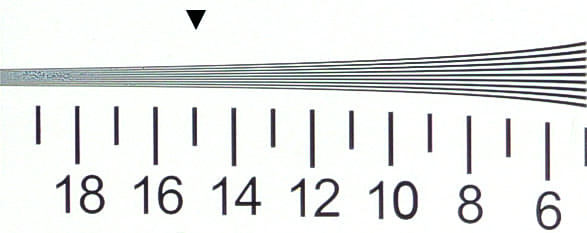
Sony Cyber-shot RX100 IV Resolution ISO 100
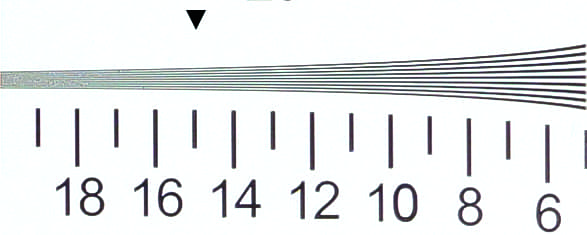
Sony Cyber-shot RX100 IV Resolution ISO 200

Sony Cyber-shot RX100 IV Resolution ISO 400
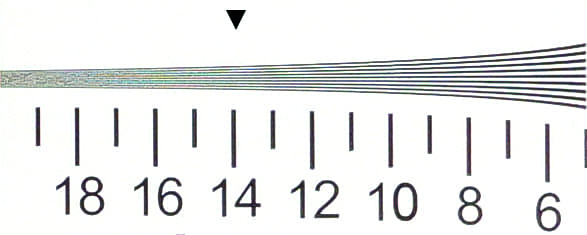
Sony Cyber-shot RX100 IV Resolution ISO 800

Sony Cyber-shot RX100 IV Resolution ISO 1600

Sony Cyber-shot RX100 IV Resolution ISO 3200
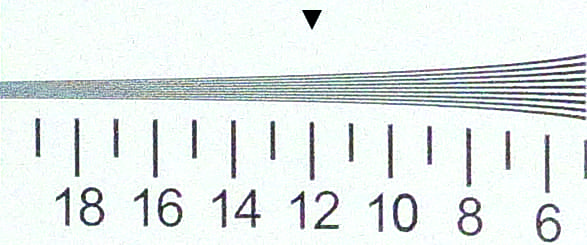
Sony Cyber-shot RX100 IV Resolution ISO 6400

Sony Cyber-shot RX100 IV Resolution ISO 12800
Noise
With the RX100 IV’s Raw files not being supported by Adobe Camera Raw at the time of testing, we reverted to using Capture One Pro v8.3.2 to process our images. As can be seen below, very smooth results are created from raw files right up to ISO 800, with luminance noise starting to creep in at ISO 1600. Detail holds up very well at ISO 3200 and although finer details are’t as well resolved at ISO 6400, you could push to this setting and achieve a useable result in an emergency.
Those who want to preserve the very best image quality will want to ensure they’re shooting in raw and use the camera between ISO 80-800, only pushing to ISO 1600-3200 when low-light conditions insist that you must. Colour noise is also more obvious in JPEG images at ISO 6400 and 12,800 than it is in Raw files.
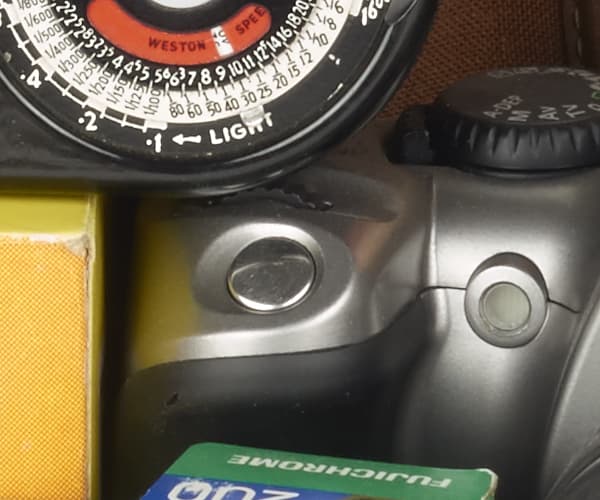
Sony Cyber-shot RX100 IV Noise, Raw ISO 80
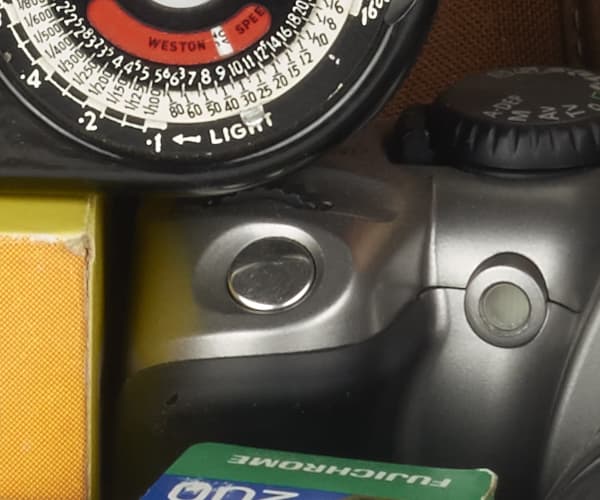
Sony Cyber-shot RX100 IV Noise, Raw ISO 100
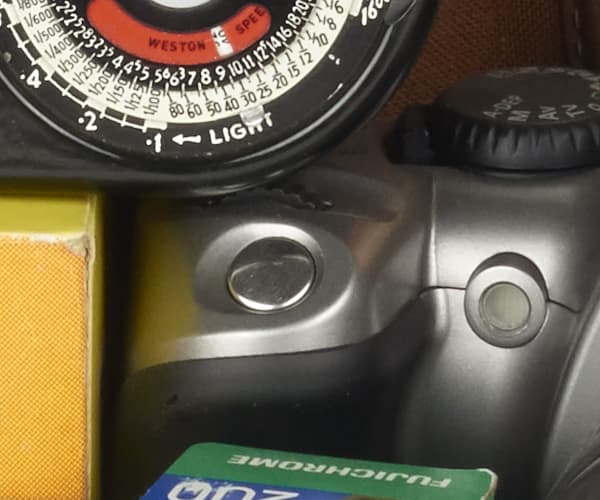
Sony Cyber-shot RX100 IV Noise, Raw ISO 400

Sony Cyber-shot RX100 IV Noise, Raw ISO 800
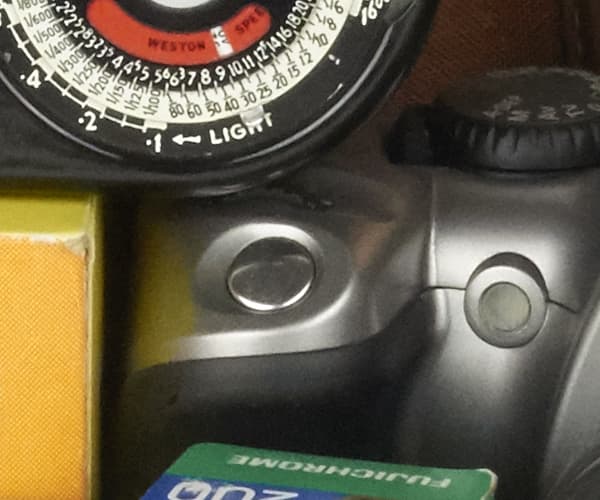
Sony Cyber-shot RX100 IV Noise, Raw ISO 1600
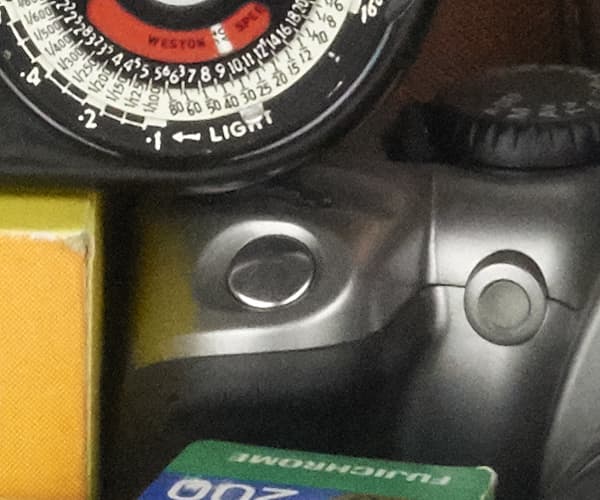
Sony Cyber-shot RX100 IV Noise, Raw ISO 3200
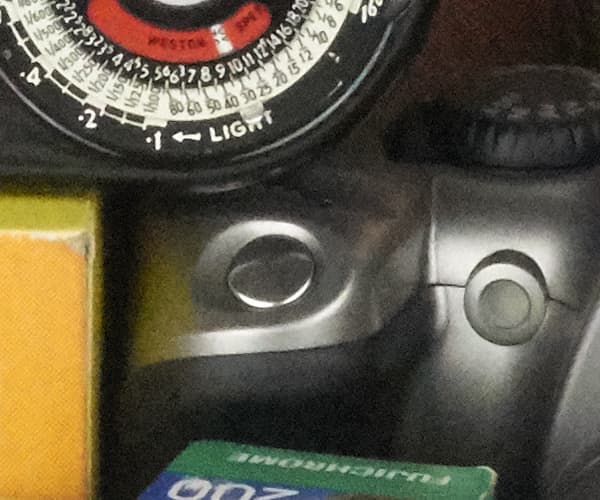
Sony Cyber-shot RX100 IV Noise, Raw ISO 6400
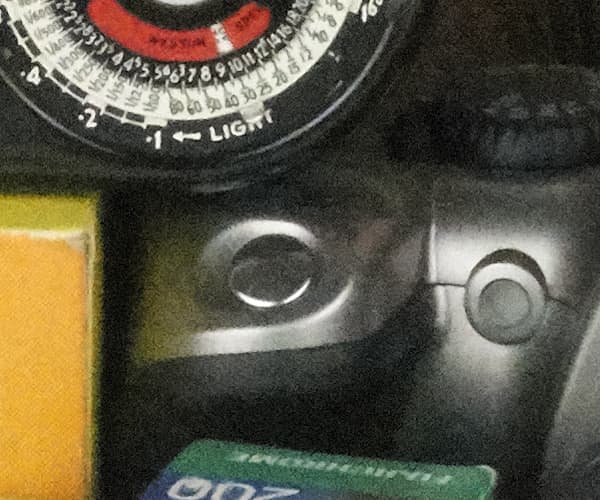
Sony Cyber-shot RX100 IV Noise, Raw ISO 12800
Sony Cyber-shot DSC-RX100 IV – Our Verdict
The improvements that have been made to the RX100 IV are centred around its new sensor. The repositioning of the high-speed circuitry has resulted in it being able to shoot faster and offer unique video capabilities such as high frame rate mode that allows you to record super slow motion footage. It’s fascinating creating slow motion movie clips and gives photographers the opportunity to capture the fastest moving subjects in a unique way. The introduction of ultra high-resolution 4K video and the sharper viewfinder sees it advance upon the RX100 III in other areas too.
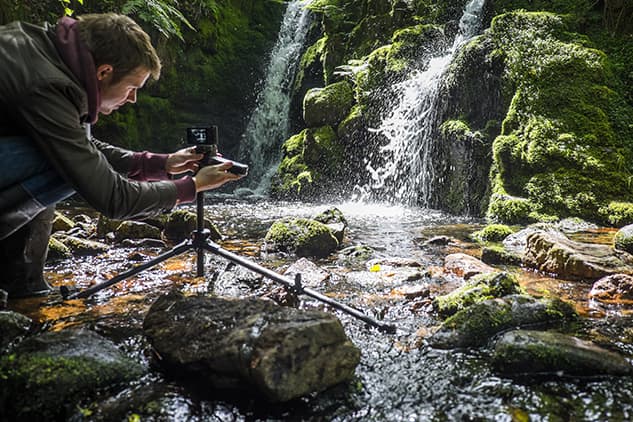
AP’s Deputy Technical Editor, Michael Topham puts the built-in ND filter to good use to create long exposures
The autofocus and image quality performance is extremely impressive for a camera so small, though our thorough testing revealed it doesn’t appear to offer any advantages in these criteria over its predecessor. The extra demands of the new sensor ask more of the battery, but the fact it can be charged via USB does mean you can charge it in the car between locations, just like I did, or alternatively you could use a USB power bank out on location. Another feature that proved its worth out in the field was the built-in ND filter – ideal for long exposures and instances where you’d like to dial in a slower shutter speed to capture movement.

AP’s Deputy Technical Editor, Michael Topham tests the Sony Cyber-shot RX100 IV out on location
For trips away and times when you don’t want to carry a camera larger than one that can fit in your pocket, the RX100 IV is a perfect travel companion. The fast lens and excellent level of customisation allows you to get creative with the images you take in the way you’d like to control the camera. A rubberised or pronounced hand grip like that found on the Sony Cyber-shot HX90V would have prevented it slipping from my hands out in the field – thankfully my quick reactions prevented any serious damage on test.
The introduction of a touchscreen would also enhance focus point positioning as well as reviewing images in playback mode and we’re hopeful that this will be introduced in the future. Other than these two points and its slightly limiting battery stamina, it’s a pocket compact that’s a pleasure to use and delivers superb image quality. It doesn’t come cheap however and its £849 asking price might be a bit of a stretch for some. Those who feel they can live without the advanced video functionality and new speed benefits can (at the time of writing) make a £280 saving opting for the older, but still excellent Sony Cyber-shot RX100 III.










